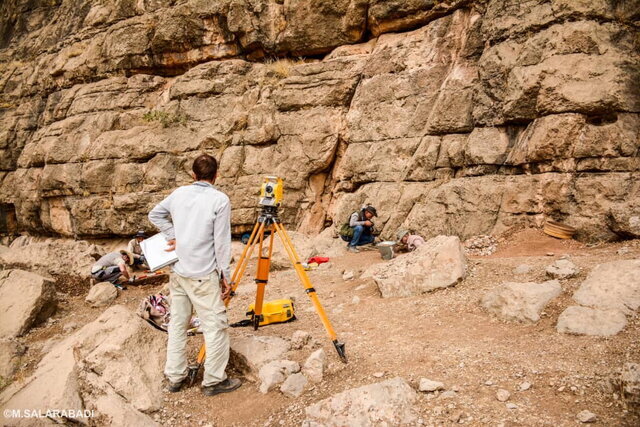Field survey traces Neanderthal remains in western Iran

TEHRAN – An archaeological survey has commenced on the Bawa Yawan shelter and its surroundings hoped to shed new light on Neanderthal life in western Iran.
Co-led by Iranian archaeologists Saman Heydari-Guran and Ahmad Azadi, the survey also aims to demarcate boundaries of the site, which yielded an in-situ Neanderthal tooth in 2017.
In previous [archaeological] seasons, in addition to the discovery of a 42,000-year-old Neanderthal tooth, archaeological layers embracing cultural data from Paleolithic, Middle Neolithic, and post-Paleolithic periods were identified, ISNA quoted Heydari-Guran as saying on Monday.
The tooth, which is a lower left deciduous canine belonging to a 6 years old child, was found at a depth of 2.5 m from the shelter surface in association with animal bones and stone tools near Kermanshah.
Stone tools discovered close to the tooth belong to the Middle Paleolithic period and a series of C14 dating suggests the Neanderthal is between 41,000-43,000 years of age which is close to the end of the Middle Paleolithic period when Neanderthal disappeared in the Zagros.
Neanderthals were roaming over the Iranian Zagros Mountain sometimes between 40 to 70 thousand years ago.
“In addition to demarcation and documentation projects, we hope to create a better situation to preserve Bawa Yawan shelter in a more favorable way using photogrammetric techniques,” the senior archaeologist said.
A previous study performed by Heydari-Guran based in the Neanderthal Museum in Mettmann, and his international fellows such as Stefano Benazzi, who is a physical anthropologist at the University of Bologna, the analysis showed the tooth has Neanderthal affinities. Conducted by a team of archaeologists and paleoanthropologists from Iran, Germany, Italy, and Britain, the results of the study appeared on the online journal PLOS ONE in August.
“Neanderthal extinction has been a matter of debate for many years. Discoveries, better chronologies, and genomic evidence have done much to clarify some of the issues. This evidence suggests that Neanderthals became extinct around 40,000–37,000 years before the present (BP), after a period of coexistence with Homo sapiens of several millennia, involving biological and cultural interactions between the two groups.”
However, the bulk of this evidence relates to Western Eurasia, and recent work in Central Asia and Siberia has shown that there is considerable local variation. Southwestern Asia, despite having a number of significant Neanderthal remains, has not played a major part in the debate over extinction” according to Heydari-Guran who led the Bawa Yawan excavation project.
In a review of the present study, Fereidoun Biglari, a Paleolithic archaeologist at Iran National Museum, has said: “This recent discovery, along with other Neanderthal remains previously found in other parts of Zagros, including Shanidar Cave, Bisotun Cave, and Wezmeh Cave, indicate that Neanderthals were present in a wide geographical range of Zagros from northwest to west of this mountain range since at least 80,000 until about 40,000-45,000 years ago when they disappeared and Homo Sapiens populations spread into the region”.
The Bawa Yawan is the second Neanderthal tooth that has been discovered in Iran. The first Neanderthal tooth was discovered in the Wezmeh cave near Kermanshah in 2001.
Moreover, the discovery of the third tooth of the Neanderthal child was announced by a joint Iranian-French team that was discovered in Qal-e Kord near Qazvin in 2019. These discoveries show that Iran has a rich paleoanthropological record and the country can produce important data in the future.
A 2019 study published in the Journal of Human Evolution, suggests that Neanderthals were roaming over the Iranian Zagros mountain range sometimes between 40 to 70 thousand years ago.
Until the late 20th century, Neanderthals were regarded as genetically, morphologically, and behaviorally distinct from living humans. However, more recent discoveries about this well-preserved fossil Eurasian population have revealed an overlap between living and archaic humans.
Neanderthals lived before and during the last Ice Age of the Pleistocene in some of the most unforgiving environments ever inhabited by humans. They developed a successful culture, with a complex stone tool technology, that was based on hunting, with some scavenging and local plant collection. Their survival during tens of thousands of years of the last glaciation is a remarkable testament to human adaptation.
Zagros mountain range in southwestern Iran, extending northwest-southeast from the border areas of eastern Turkey and northern Iraq to the Strait of Hormuz, is about 990 miles (1,600 km) long and more than 150 miles (240 km) wide. It forms the extreme western boundary of the Iranian plateau, though its foothills to the north and west extend into adjacent countries.
According to Britannica, the oldest rocks in the Zagros range date to Precambrian time (that is, before 541 million years ago), and the Paleozoic Era rocks date to between 541 million and 252 million years ago are found at or near the highest peaks.
Most of the rocks in the mountain range, however, are limestone and shale from the Mesozoic Era (252 million to 66 million years ago) and the Paleogene Period (66 million to 23 million years ago). The range was primarily formed by orogenies (mountain-building episodes) driven by the movement of the Arabian Plate underneath the Eurasian Plate during the Miocene and Pliocene epochs (23 million to 2.6 million years ago).
AFM

Leave a Comment